📢 Sign up to my newsletter and never miss a beat!
Users often feel perplexed over choosing the right pricing plan for them, especially when faced with complex product offerings. This is the case with many SaaS companies providing all-in-one solutions that cover various functionalities and features. While this can help you cater to more user personas and, in that way, increase your serviceable addressable market, it also makes the whole decision making process for your prospects more obscure and overwhelming. If, as a SaaS provider, this sounds familiar to you, continue reading to explore my top suggestions on how to help your prospects navigate through the complexity of different pricing plans and make an informed choice that best suites their needs.
1. Tie each pricing plan to a specific user persona and make it relatable
Depending on the type of your product and the pricing model you`ve decided to adopt, the general rule is that each pricing plan should correspond to an individual user persona and cater to their specific needs and requirements, so try to keep as close to that idea, as possible. It’s also not something unlikely to target more user personas than the number of your pricing plans. In fact, many SaaS businesses stick to the rule of having no more than three pricing plans (which is considered the optimal number of plans), while they are still targeting more user personas with their offering. If that`s your case, you still need to make sure it`s clearly communicated which are the intended audiences for each of your plans, so that prospects can quickly identify the plan that aligns with their needs, business level, and size.
Some specific techniques you can apply to make your pricing plans look more recognizable and relatable to the user personas they signify, may include:
1.1. Name each plan after the persona it represents
One of the steps you can undertake is to name your plans after the individual personas they represent. This is not something common in the SaaS industry, but it will definitely make an impact. If the type of your product allows it and you have one persona per plan, it is worth considering it, аs this approach adds a personalized touch and instantly draws the user`s attention to the plan most likely to match him.
Mindthegraph, an online infographic maker for science, uses this method to facilitate its website visitors and prospects to quickly orient toward the plan that is right for them.
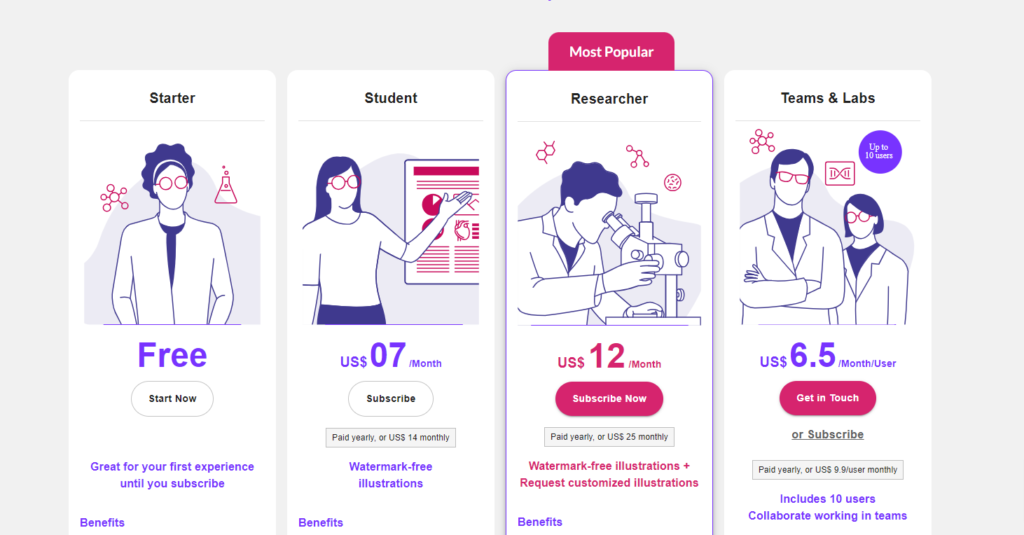
1.2. Include illustrations embodying the specific persona you are targetting with each tier
Visuals are eye appealing and tend to grab people’s attention more effectively than text. They are an easy and quick way to convey key information to your audience and simplify your message. You can use illustrations for your different plans on your pricing page to communicate whom this plan is developed for and to attract prospects to the option most suitable for them. This visual representation is an instant cognitive shortcut that will save them time in figuring out which plan is the right one for them.
Mindthegraph, as well as many other SaaS businesses, have adopted this approach quite successfully.
1.3. Include a brief description below each plan indicating who is this most suitable for
Another way to communicate who is the intended audience for each plan is to include a brief description below their titles. In fact, this method is common and you`ll see it on many SaaS products. Provide a short and exact explanation on who particularly this plan is designed for and whose needs are addressed with it.
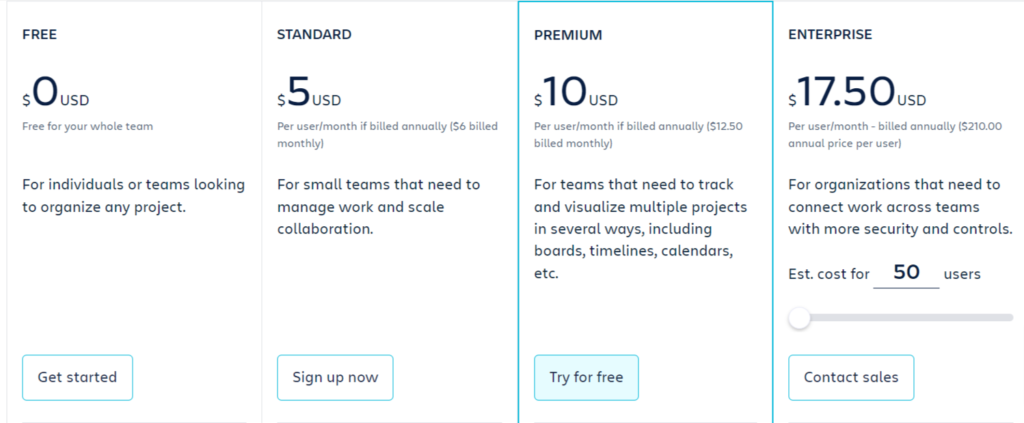
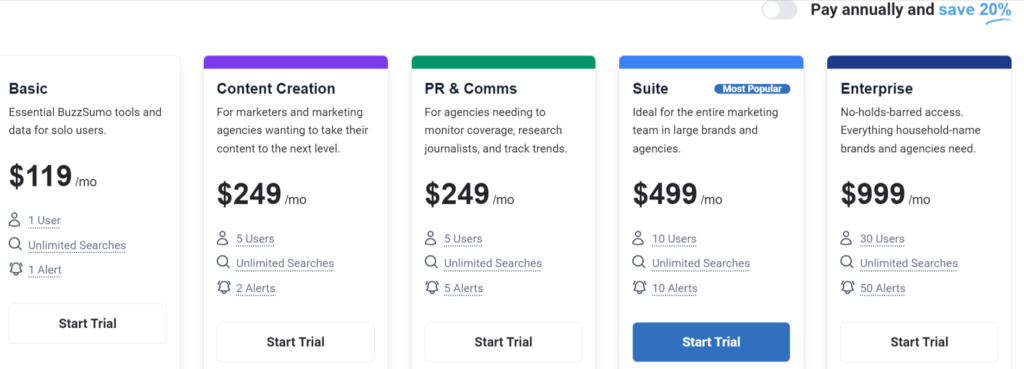
2. Make a personalized recommendation based on the information new users provide
You may have come accross some SaaS products that have an automated flow of questions being asked upon registration. Then, based on your answers, the algorithm makes an assessment on what is the best option for you and gets you straight to the particular tier or product (in case the tool supports several platforms with different functionalities, each designed for different roles or industries) that meets your requirements. This approach eliminates the guesswork from the user, saving him time in reading and comparing different plans, while at the same time personalizes his experience right from the start of this user journey.
In order to make this possible, you have to have gathered enough information on your target audience and be well aware of your different buyer personas, as well as their individual needs, goals and what they`re trying to achieve. This will allow you to see particulur patterns and to come up with the right questions to ask. You`ll also need to design a system in place that will enable the whole exercise to take place both at the frontend and backend side. Based on the different patterns you have identified from the data you have on your target users, you`ll know what parameters to set to each question and then adjust the algorithm accordingly, so that it matches each user that goes through the question flow with the right solution. This is a process that can be iterative as, the more information you`re getting about your users and the more you learn about them over the time, the more you`ll be able to optimize the system.
Wrike is an example of a project management tool that has incorporated this strategy into their setup process quite successfully.
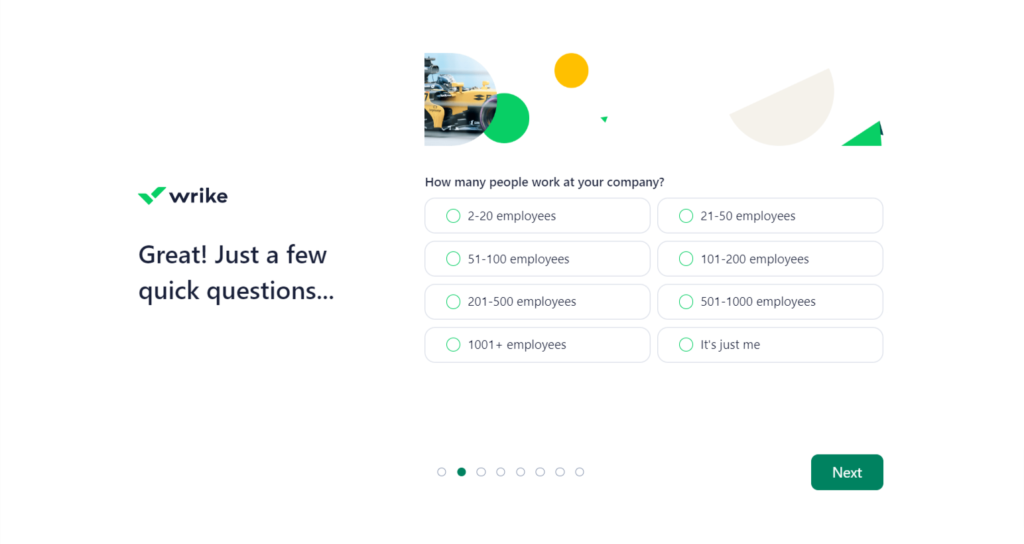
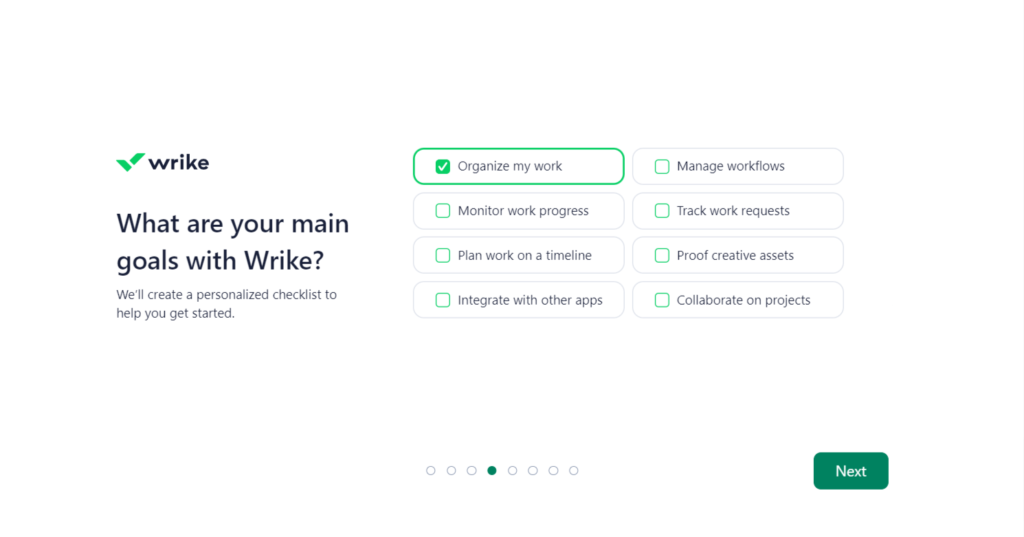
3. Create a brief outline of the core features of each plan
If your plans offer plenty of different features and functionalities, this is likely to make users feel overwhelmed and lost as they read, compare and further examine your pricing tiers. The more options they`re presented with, the more confused they`ll get, which will eventually lead to a decision paralysis. To help them make a better choice for themselves, while also saving them time and details of less importance, consider including a brief outline covering only the main functionalities and/or core problems your product solves at each level. This will direct their attention to the right tier and eliminate a lot of the hesitation. Of course, you will still need to provide a detailed list of all the features, usage volume and other particulars each plan has, as well as comparison charts, should your prospects decide to explore and see more, but this needs be distinguished from your outline section.
Here is an example from Zapier. In their summary section under each plan, they outline three to four of the plan`s main functionalities and capabilities. Right below it there is a section “Compare Plans and Features”, which lists all features and looks at the details of each plan.
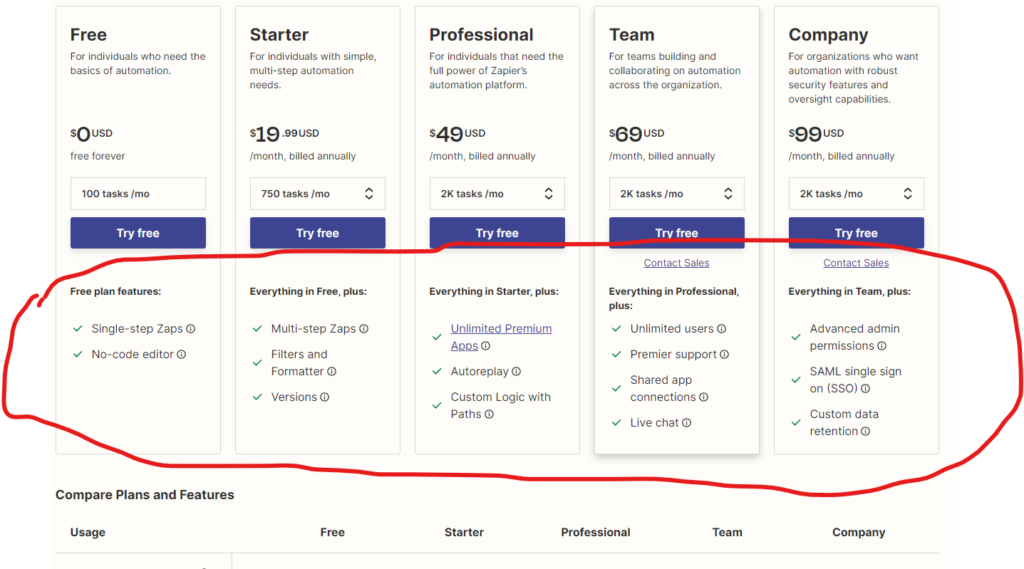
At Zoho they decided to provide an overview of the main features beneath each plan (although it consists of more details rather than just a brief outline), while including a link to the full list of functionalities and features (and a downloadable pdf), wish you to explore more.
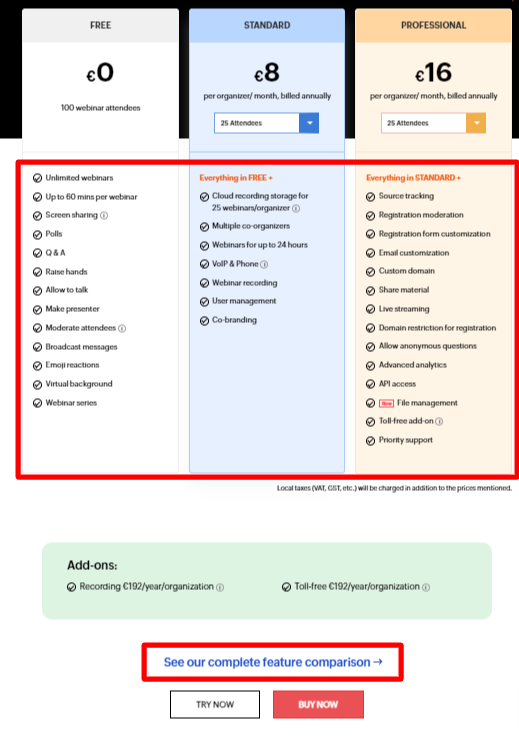
4. Organize features under main categories
In the case of SaaS products supporting multiple categories of features (as many of them are today), as well as in the case of the more complex products, users may be interested in only some of the functionalities offered and willing to sign up even if they don`t need the other things in the package. Other people have strong preference for few feature categories, while perceiving the rest as just nice-to-have оr functionalities of less importance.
In order to help these potential users make a decision on which plan best suits their needs, organize what your plans include in a way that the features in your feature lists are grouped under certain categories. This will create a mental shortcut for your users and let them quickly find the information they need and the specific area that interests them, eliminating the other “noise”.
The pricing page of ActiveCampaign is a great example of how this can be sorted. Note how features are listed under parent functionality groups. For example, if you are looking at their marketing platform and you`re mostly interested in what automation capabilities it offers, you have all features related to it cataloged under “Automations”
5. Include a live chat option on the pricing page
Having a live chat option on the pricing page (or at whichever step of the buyer`s journey is, where they are prompted to pick a plan), can significantly help your prospects in their decision-making. It gives them instant access to customer support representatives who can answer questions and provide clarification about the different pricing plans, should they need such. Furthermore, a live chat enables cs agents to engage in personalized conversations with potential users. By understanding the specific needs and requirements of the user, the agent can suggest the most appropriate pricing plan that aligns with the user’s needs, budget, and usage patterns. He can also address potential concerns and objections the user might have while considering the product`s different pricing plans, which helps to overcome potential barriers to purchase and ease any doubts the user may have.
6. Have a clear and concise faq section on your pricing page
Another way to help your users in their decision-making on which plan best suits them is to include a well-crafted Frequently Asked Questions (FAQ) section on your pricing page or/and on the step where they need to pick which plan they`d like to subscribe to. In fact, you`ll see that this is a common practice among many of the SaaS companies.
To create a FAQ section that really helps your prospects, you need to identify what are the common concerns, objections, or doubts they may have and address them in a clear and concise way, by answering the main questions that are most likely to arise. This will alleviate uncertainties, without requiring users to engage in a live chat or contact customer support (many of them actually prefer to find the information they need by themselves). This expedites the decision-making process by providing immediate answers to their queries.
In the case when pricing plans and structures are complex, the FAQ section is a great place where you can clarify what’s included in each plan, any limitations, and how they relate to different user scenarios.



